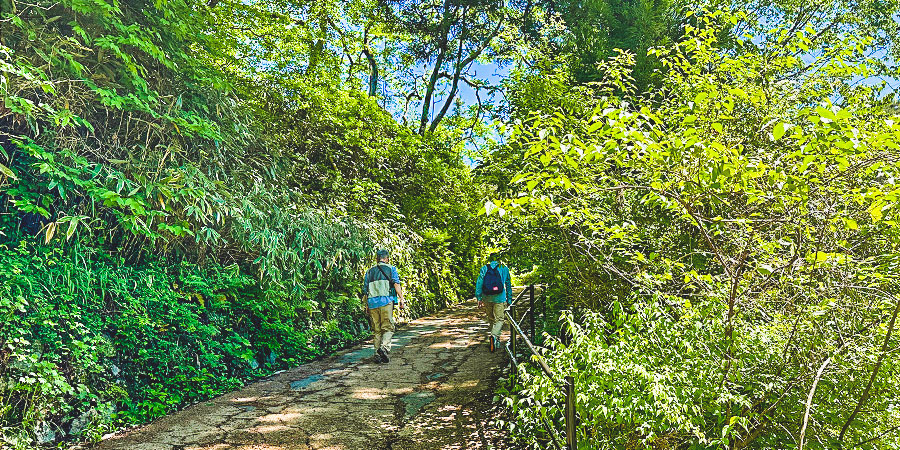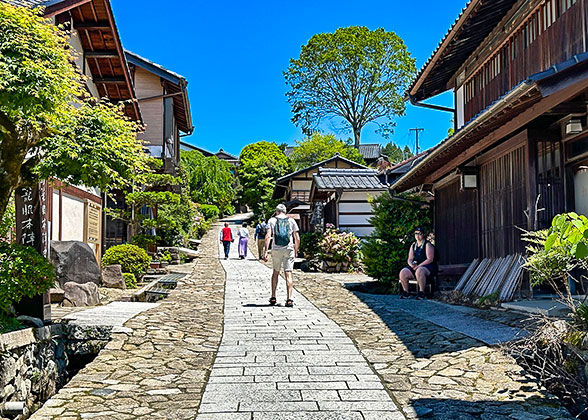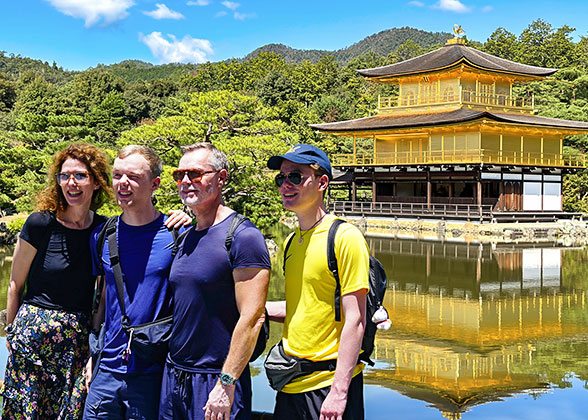Kumano Kodo Pilgrimage Routes
Stretching across Kii Peninsula from north to south, Kumano Kodo is one of the most well-known pilgrimage routes in the world. It is a huge network of ancient trails through majestic ridges, primordial forests and along the coast.For the past over 1,000 years, hundreds and thousands of people including emperors, noblemen, and common people have been taking these arduous routes to Kumano Sanzan - the Three Grand Shrines of Shinto and Buddhism. There are also numerous Oji subsidiary shrines along the roads. Undoubtedly, Kumano Kodo has a profound significance for Japan’s history and beliefs.
The ancient routes were included on UNESCO’s World Heritage list as a part of the “Sacred Sites and Pilgrimage Routes of the Kii Mountain Range” in 2004, making Kumano Kodo one of the only two pilgrimage routes in the world, along with the Way of St. James (Camino de Santiago) in Spain.

Kumano Kodo Pilgrimage Routes
|
6 Ancient Pilgrimage Routes of Kumano Kodo
Kumano Kodo consists of 6 routes connecting different places of worship, of which Nakahechi is the most taken one.1. Ohechi: A coastal route which is 92 km long (57 mi.) from Tanabe to Nachikatsuura. The beautiful natural scenery along this route attracts many writers and artists.
2. Nakahechi: This most popular route starts from Tanabe to the Kumano Sanzan, which was used by not only the imperial families but also common people in the past. Traditional inns are available along the way.
3. Kohechi: 70 km long (43.5 mi.) from the Buddhist temple complex of Mount Koya to Kumano Hongu Taisha Grand Shrine. The trail is steep across the hills and mountains.
|
|
|
4. Iseji: 170 km long (105.6 mi.) from Ise-jingu Shrine to the Kumano Sanzan. Along the way there are mountains, bamboo forests and beaches.
5. Kiiji: Connecting Kumano with Kyoto and Osaka, this route features many historical relics as well as natural beauty.
6. Omine Okugake michi: 170 km long from Yoshino to Kumano Hongu Taisha Grand Shrine via Mount Omine. It’s also a long and difficult route.
Kumano Sanzan - Three Grand Shrines at the End of the Pilgrimage Trails
1. Kumano Hayatama Taisha Grand Shrine: Located besides Kumano-gawa River, it enshrines 2 gods who are husband and wife. Inside the shrine there is a grand Asian bayberry planted by Taira no Shigemori - a Japanese military commander - in 1159 to memorize the construction of the shrine.

A Local Shrine
|
3. Kumano Nachi Taisha Grand Shrine: This shrine derives from the ancient worship to the nearby Nachi Waterfall - Japan’s tallest waterfall. The shrine buildings, shaded in forest, are painted bright orange, giving sharp but beautiful colorful contrast. The annual Nachi Fire Festival is a highlight of it.
Yatagarasu - Symbol of Kumano Kodo
Along the roads of Kumano Kodo, a bird motif can be seen in many places: a three-legged crow called Yatagarasu. It is believed to be a divine messenger of the god, guiding worshippers the correct direction.Yatagarasu symbolizes the three layers of the cosmos, three ancient clans of Kumano and three virtues of the god in Kumano Hongu Taisha Grand Shrine. Also it has become the logo of Japan Football Association.
Collect Some Stamps on Your Own Journey
A variety of commemorative stamps can be collected along the routes of Kumano Kodo. They are usually placed in small wooden structures of the Oji subsidiary shrines and Grand Shrines. Official booklets are available and you can also collect the stamps wherever you like.Besides, people who complete both Kumano Kodo and the Way of St. James can get a “DUAL PILGRIM” certificate for commemoration.
Tips on Hiking on Kumano Kodo
1. It may be humid, overcast and slippery in the woods, so please wear hiking shoes and appropriate clothes and take a raincoat.2. Take enough water and food, especially when the weather is hot.
3. Take away all garbage and leave no trace.
4. Some wild creatures like bear, snake and leech may appear in the mountains. Please be careful and keep distance with them.
5. A paper map or offline map is necessary due to the intricate mountainous paths.
6. Take a trekking pole to protect your knees when hiking.

Hiking along Kumano Kodo
|
How to Get to Kumano Kodo
The way to Kumano Kodo mainly depends on the destination and hiking itinerary. Here are some recommendations.1. To Kumano Hongu Taisha Grand Shrine
Step 1: Take a plane to Nanki-Shirahama Airport and take a bus to Kii-Tanabe Station. Or take a JR train to Kii-Tanabe Station.Step 2: Take a Ryujin Bus for about 15 minutes and get off at Kumano Hongu Taisha-mae bus stop. The last bus leaves at 16:40.
*If you want to walk the Nakahechi route to Kumano Hongu Taisha Grand Shrine, you may start from Kii-Tanabe Station.
2. To Kumano Hayatama Taisha Grand Shrine
You may take a JR train to Shingu Station and walk northwest for about 15 minutes to get there.3. To Kumano Nachi Taisha Grand Shrine
You may take a JR train to Kii-Katsuura Station and take a bus for about 30 minutes to get to the shrine.You May Like
-
 10 Days Private Tour of Tokyo - Mt. Fuji - Tokyo - Nagano - Matsumoto - Nakasendo Way - Kyoto - Osaka from USD2859
10 Days Private Tour of Tokyo - Mt. Fuji - Tokyo - Nagano - Matsumoto - Nakasendo Way - Kyoto - Osaka from USD2859 -
 8 Days Mini Group Tour to Tokyo - Hakone & Mt. Fuji - Kyoto - Nara - Osaka - Hiroshima - Osaka from USD2771
8 Days Mini Group Tour to Tokyo - Hakone & Mt. Fuji - Kyoto - Nara - Osaka - Hiroshima - Osaka from USD2771 -
 11 Days Mini Group: Tokyo - Hakone (Mt. Fuji) - Kyoto - Nara - Osaka - Hiroshima - Kanazawa - Shirakawa-go - Takayama - Tokyo from USD3554
11 Days Mini Group: Tokyo - Hakone (Mt. Fuji) - Kyoto - Nara - Osaka - Hiroshima - Kanazawa - Shirakawa-go - Takayama - Tokyo from USD3554

